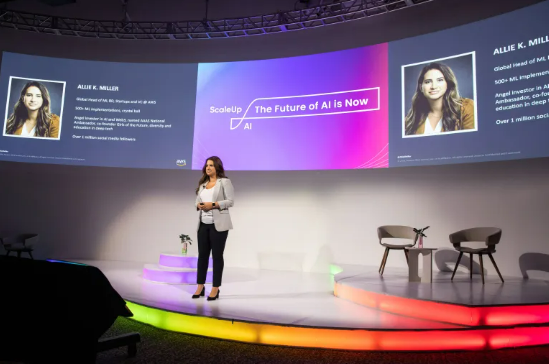The major issues around artificial intelligence in health care come down to less about the amount of data and more about data sharing, quality and reliability.
Those were the key issues members of the VisionAIres community shared in the monthly roundtable discussion comprising AI business leaders from industries including finance, media, technology, government, health care, automotive, energy, utility and transportation.
“The quantity of data isn’t the problem,” said Andrew Davies, digital health lead at the Association of British HealthTech Industries, a trade association for health technology companies. “The bigger problem is getting hold of well-organized, well-curated data.”
“We’re in the early days of using AI, but it’s starting to become more widespread, particularly considering diagnostics, where we do have more things like digital stethoscopes and the use of AI diagnosing cancer and imaging.”
The most discussed issue centered around the sharing of data, not always an easy feat.
“I’m pretty excited to see data sharing back on the roadmap for a lot of big companies, particularly with regard to AI development undertakings,” said Jutta Williams, head of privacy at Bolt and former product lead for ML, ethics transparency and accountability at Twitter.
“I’ve never found it a problem sharing information with commercial providers when there’s a well-articulated patient need demonstrated,” said Simon Mortimore, assistant director for business information at South Central Ambulance Service NHS Foundation Trust.
“My frustration with a lot of commercial providers is they don’t really know what they’re doing. They kind of want the data to play with. And we we’ve got 11 projects I’m trying to roll out and I can’t get a single commercial supplier to engage because they don’t want to play (since) we’ve actually got an outcome we’ve proven to them.”
Challenges with data-sharing
Data-sharing is also not always smooth sailing, several members noted.
“Where we have a serious problem is when it gets out to certain types of organizations who desperately want our data,” said Richard Self, senior lecturer in governance of advanced and emerging technologies at the University of Derby. “They can use that to assess risk for things like insurance.”
Discussion participants were aware of some of the inherent risks with data-sharing as well.
“We are just very, very careful with work on anonymization,” said Bob Compton, IS director at RCI Financial Services. “Around what we’re using, we can’t share freely at all. We’re part of the car manufacturer group, but we have to have company sharing agreements in place. There’s a lot of compliance and regulatory issues around it.”
Even AI leaders not directly involved in health care had ideas relating to ways to share data that might be useful.
“I’m not involved in health care, but if I was, I would make an interconnection between a virtual nursing assistant such as an Alexa and a data system in hospitals so that the professionals could get some information quickly about a patient before arrival at the hospital,” said Marthe Garly Laforest Remy, CEO of HermesTrasport.
Data quality is paramount
While sharing data is viewed as important, there has to be confidence in the data being shared.
“Machine learning lives or dies on the quality and the amount of the data that gets fed into it,” said Felix Beacher, practice leader, health care technologies at Omdia Research.
“From our experience, especially from a health insurance point of view, it’s about trust that’s very often overlooked,” said KV Dipu, president for operations and customer experience at Baja Allianz General Insurance.
“It just cuts across every patient-insurer interaction, as well as the patient and the industry interaction. In that context, we need to overcome a lot of challenges. One is customer consent, and the other is ensuring accurate data. Because if we’re able to detect data drift, we can get into better patient and effective health care.“
“It also leads to more informed decision-making, and better patient-targeting, and these have been some tangible benefits that we’ve seen from our experience. Also, it helps if we’re looking at a patient as a relationship in terms of better patient-physician relationships.”
“The thing that I kind of think about with synthetic or self-extrapolated data is how you determine credibility,” said one VisionAIres member.
“At what point do you start giving like a certain percentage where it goes from a scale of zero to 100, how you would actually figure that part out, because at some point or another, let’s say you collect 1,000, sample sizes versus 10,000, sample sizes, you’re talking about a much larger range, so the larger the range of the data, the more credible it becomes.”
Forecasting with data
Some of the current data being collected is aimed at helping predict future behaviors, such as Autotrader.com, which is looking to forecast future locations for chargers for coming electric vehicles (EVs).
“The big challenge is how do we know who’s going to be buying them?” said Nick King, market research and insight director at Autotrader.com.
“We use data completely. We don’t just use our own data, we use external data that can help us understand the demographics of where people are living, their household income.“
“We use demographics to help get some data so that we’re now beginning to advise the government seriously on where they should be putting their charges because what we’re finding is electric vehicles tend to be a bit more expensive than your standard internal combustion engine cars, and they’re bought primarily by the wealthy individuals who live outside of towns and have a drive so they can charge their vehicle.“
“By using literally search data, we have 11 million people coming home straight every month. We can work out where are the hotspots, who’s searching, where do they live, and when we break it down and overlay with ocean demographic data, we can see our there’s real dividing lines.“
“In London, if you look at a heat map where blue is cold and red is hot, you’ve got completely different areas abutting each other with interest and no interest. What you can do, is you see the areas where we should be investing our money in chargers. And these are the areas where we aren’t. We’re trying to use our data and masses of it to help this country embrace a new technology.”
Other data challenges were highlighted by VisionAIres members.
“In health care, the data is not great, but there are also a lot of problems with liability,” said Javier Campos, head of data labs at Experian. “One of the things with health care and financial data is that there is a massive correlation. The worse you are financially, the worse your life expectancy is going to be.”
And despite the amount of data being generated, some businesses still need more.
“We never have enough data, and we don’t have it organized well enough,” said Daryl Gest, executive director technical products at CDF Capital.
“That is everybody’s story, it sounds like, and those are the challenges of getting together. That whole sensitization of data is really interesting to us and financial services as well. We have some interesting privacy things as well. It’s simpler, I think, than health care. But nonetheless, something we have to deal with all the time.”
Regulatory and personnel concerns
The issue of the regulation or governance of AI also is frequently raised in the industry leaders’ discussions.
“Regulation is the biggest issue if somebody can get sued if you use their data — that is the biggest challenge in the U.S.,” said James Odeyinka, technical architect and cyber security leader at Walgreens.
Various issues relating to people regularly come up in the monthly virtual roundtables.
“If you want to work with the data science team, or machine learning people, make sure that you bring a strategist in,” said Odeyinka.
“It is true that we can go to the government, it takes years to tell them, hey, I need this to protect this type of women, I need this to protect this type of men. It will take years to convince them. But we can use strategy. And that’s what I call scoping.”
Many businesses also are challenged to find, finance and retain AI talent.
“It’s very hard to hire AI people,” said Williams from Bolt. “At Twitter, the fully realized cost in the first year of an AI developer or machine learning scientist was over $1 million, at least in the United States. The average margin for health care companies is about 3%, which is just barely enough to keep the lights on.”
The next VisionAIres virtual roundtable is scheduled to be held on March 24 on AI automation.
Written by Chuck Martin and republished with permission from AI Business.



